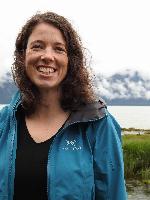Student-Created Place-Based Documentaries and Podcasts
,
Colorado Convention Center, Bluebird Ballroom 3AB
Presenters

Session description
Purpose & objective
Participants will learn how to design and implement an interdisciplinary place-based documentary unit. Laura will explain the importance of providing a theme for the unit that provides direction and focus while empowering students to be creative. Participants will learn ways to help students brainstorm ideas for their films, how to recruit community members for the films, and how to edit films. Laura will explain how she taught students how to use the film equipment and how she encouraged leadership and teamwork so that her students shared responsibilities when filming the documentaries. Participants will learn about the community film festival that showcased the student-made documentaries. Laura will explain how she fundraised for film and audio equipment for her students using Donors Choose and seeking financial support from community members and businesses. Participants will learn how Laura organized and led an after-school club in which students in grades 6-9 created documentaries and podcasts. Participants will watch some of Laura's students' documentaries and listen to excerpts from her students' podcasts. Participants will learn how to access See Stories free resources. Laura will explain how participants can set up their own after-school documentary and podcast clubs. Laura will talk about using ClimpChamp for editing, however, she will highlight how you can edit videos using other programs like Canva or make simplified videos using Microsoft Flip.
Outline
Introduction: 5 minutes- Laura will introduce herself, and the objective of the presentation, and provide an overview of the schedule. Laura will briefly describe her film and podcast projects and the benefits of this type of learning opportunity for students.
Opening- Film Festival: 10 minutes - Laura will show excerpts of her students' place-based documentaries and podcasts.
Discussion- Feedback and Questions: 5 minutes- Laura will give participants time to discuss the films and podcasts with their peers and as a whole group. Discussion will use a "See, Think, Wonder" format.
See Stories Film Workshop, After School Club, and Podcasts: 20 minutes- Laura will describe the initial See Stories workshop that Laura's students completed. She will explain the entire process: bringing in mentors to work with students, developing a unit theme, helping students brainstorm ideas and plan films, recruiting and connecting with community members, teaching interviewing, filming and recording skills to students, editing films, and showcasing films. Laura will share about her after-school program and the support, inspiration, and guidance See Stories has given her. She will share See Stories' mission, describe the work they do in Alaska, and the free resources available to educators. Laura will highlight how the films and podcasts celebrate the local Alaska native culture, the beautiful natural world and wildlife, and local traditions and industries like fishing.
Technology and Equipment: 10 minutes - Laura will share a list of video and audio equipment that she uses with her students. She will also talk about ClipChamp the editing software students used on their Chromebooks to create the films. Laura will brainstorm with participants about other video editing software that students can use to edit films. Laura will teach participants how she fundraised by seeking donations in her community and using Donors Choose to raise money to purchase equipment.
Group Discussion and Questions: 10 minutes -Laura will lead an interactive discussion with participants about the benefits of place-based learning, especially relating to creating films and podcasts. She will lead a short brainstorming session with participants to encourage them to think of local culture and community members they could incorporate into a future unit for students. Laura will also lead a discussion about the benefits of students creating documentaries and films and highlight the benefits and skills gained by students. Laura will share challenges, offer tips for overcoming challenges, and ask participants to share any general questions.
Supporting research
https://seestoriesalaska.org/
Session specifications
Laptop: Chromebook, Mac, PC
Tablet: iOS, Android, Windows
Creative Communicator
- Students create original works or responsibly repurpose or remix digital resources into new creations.
- Students use digital tools to connect with learners from a variety of backgrounds and cultures, engaging with them in ways that broaden mutual understanding and learning.
- Students contribute constructively to project teams, assuming various roles and responsibilities to work effectively toward a common goal.
 Return
Return Listen and learn: Edtalk
Listen and learn: Edtalk  Trips and Tours
Trips and Tours Streaming Session
Streaming Session Recorded Session
Recorded Session